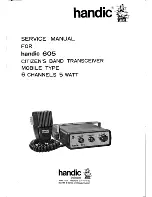
TK-2102G
22
ADJUSTMENT
Controls
Speaker/
microphone
jacks
Antenna
Monitor key
PTT switch
LED indicator
Speaker
Microphone
Power switch/
Volume control
Channel
selector
Frequency
The set has been adjusted for the frequencies shown in
the following table. When required, re-adjust them follow-
ing the adjustment procedure to obtain the frequencies you
want in actual operation.
■
Frequency
CH
RX (MHz)
TX (MHz)
1
162.10000
162.00000
2
150.10000
150.00000
3
173.90000
173.97500
4
162.50000
162.50000
5
162.55000
162.55000
6
162.60000
162.60000
7
162.55000
162.55000
8
162.65000
162.65000
9~16
-
-
Preparations for tuning the transceiver
Before attempting to tune the transceiver, connect the
unit to a suitable power supply.
Whenever the transmitter is tuned, the unit must be con-
nected to a suitable dummy load (i.e. power meter).
The speaker output connector must be terminated with
a 8
Ω
dummy load and connected to an AC voltmeter and an
audio distortion meter or a SINAD measurement meter at all
times during tuning.
■
Adjustment Frequency
TEST CH
K,M
RX (MHz)
TX (MHz)
Low
150.10000
150.00000
Center
162.10000
162.00000
High
173.90000
173.97500
Adjustment Points
TC2
TC201
TC1
Foil side view
TP2
R225
L212
TC201: Band-pass
fi lter waveform adjustment
L212:
AF level adjustment
TC1:
Transmit VCO lock voltage adjustment
TC2:
Receive VCO lock voltage adjustment
TP2: Band-pass
fi lter test point
ANT
VR500
VR501
VR1
IC403
CV
SP
MIC
CH
Component side view
ANT: Antenna
connector
CH: Channel
selector
SP: Speaker
jack
MIC: Microphone
jack
CV:
VCO lock voltage adjustment terminal
VR500: DQT waveform adjustment
VR501: MAX DEV adjustment
Note:
To fi ne tune the frequency when not using a
computer, adjust VR1.
















































